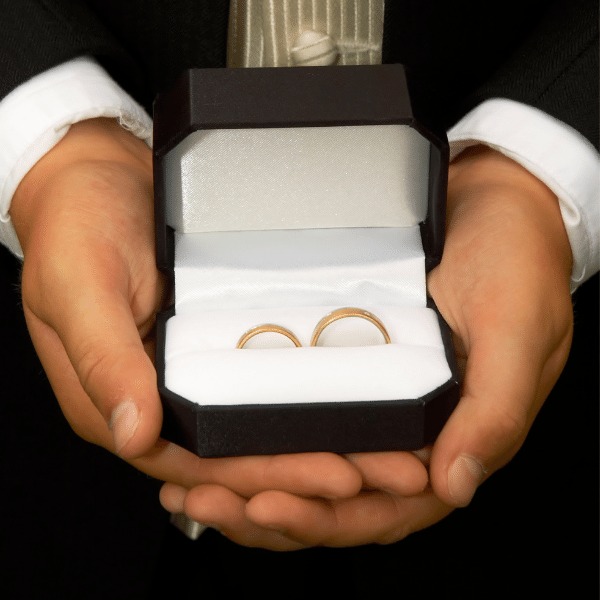Understanding the Role of the Ring Bearer at a Wedding
The role of the ring bearer at a wedding is a cherished and symbolic one, typically filled by a young child, such as a relative or a close family friend’s child. Ultimately, understanding who holds the rings at a wedding, particularly when it comes to the best man, underscores the significance of friendship and support on this momentous day.Here are the key aspects of this role:
Responsibilities
- Carrying the Rings: The primary duty of the ring bearer is to carry the wedding rings down the aisle during the ceremony. This can be done in a variety of ways, such as in a special pillow, a small box, or even a unique container that fits the theme of the wedding.
- Timing: The ring bearer usually walks down the aisle right before the bride arrives or during the processional, often accompanied by another young attendant like a flower girl.
- Presentation: Once at the front of the ceremony, the ring bearer presents the rings to the officiant or the couple, depending on the couple’s preference.
Symbolism
- Tradition: The act of carrying the rings symbolizes the union of the couple and the sharing of their lives. It represents the idea of trust and responsibility, even from a young age.
- Inclusion: Having a ring bearer can help include younger family members in the ceremony, making them feel special and part of the significant event.
Tips for a Successful Ring Bearer Experience
- Rehearsal: Ensure the ring bearer is comfortable with their duties by including them in the rehearsal. This helps familiarize them with the setting and the expectations.
- Age Consideration: Select an age-appropriate child, usually between 3 to 10 years old. Younger children may need more guidance, while older ones can understand their responsibilities better.
- Practice: If the child is nervous, practicing their walk down the aisle can help alleviate anxiety. Consider making it fun by having them practice with a small group.
- Outfit: Coordinate the ring bearer’s outfit with the wedding theme. Whether formal attire or something more playful, ensure it matches the overall aesthetic of the wedding.
- Alternative Options: If a child isn’t available or suitable for the role, adults (like a younger sibling or even a close friend) can step in as the ring bearer.
Conclusion
The ring bearer plays a delightful role in wedding ceremonies, often endearing themselves to guests and adding a touch of innocence and joy to the event. Proper planning and consideration can ensure a smooth experience for both the ring bearer and the happy couple.
Traditional Roles

Best Man and Maid of Honor:
In many Western cultures, the best man is responsible for holding the groom’s ring, while the maid of honor holds the bride’s ring. This tradition places the responsibility on close friends or family members who have a significant emotional investment in the couple’s relationship.
Ring Bearer:
Another common practice involves having a ring bearer, usually a young boy, carry the rings down the aisle. This can add a charming, light-hearted element to the ceremony. In cases where a couple uses fake rings for the ring bearer, the real rings are often kept with the best man or another trusted individual.
Cultural Variations
Alternative Custodians:
In some cultures, other relatives or members of the wedding party may hold the rings. For example, a sibling or even a parent of the bride or groom may take on this responsibility, depending on the family dynamics and cultural practices involved.
Ceremony Variations:
Certain cultural or religious wedding ceremonies may have specific customs regarding ring handling. Orthodox Christian weddings often involve the rings being blessed by a priest, whereas some indigenous ceremonies may incorporate the rings into unique rituals.
Personal Choices
The Couple:
Some couples prefer to hold their own rings until the moment they exchange them. This choice can reflect a desire for more personal involvement and can make the moment feel even more intimate.
Wedding Coordinator or Officiant:
In certain cases, especially in more modern or elaborate ceremonies, a wedding coordinator or the officiant may temporarily hold the rings until they are needed. This can ensure that the rings are safely kept before their exchange.
Creative Alternatives

Unique Holders:
Couples looking for a creative twist may choose unconventional holders for their rings. Some options include:
- Ring pillows adorned with flowers or lace.
- A decorative box or container that reflects their wedding theme.
- A family heirloom or keepsake that holds sentimental value.
Involvement of Guests:
For a distinctive experience, some couples have their wedding guests involved in the ring exchange. This could be through a “ring warming” ceremony, where guests pass the rings around to bless them before they reach the couple.
Logistical Considerations
Keeping Track of the Rings:
When deciding who holds the rings, it is essential to consider the logistics of the day. Ensuring that rings are secure and easily accessible at the right moment is crucial to avoid any mishaps during the ceremony.
Backup Plans:
Couples might want to have a backup plan in place in case the designated person to hold the rings has issues (e.g., being too nervous, forgetting them, or misplacing them). Having an alternate individual or a designated location may help mitigate any stress.
FAQs About Who Holds the Rings at a Wedding
Certainly! Here are some frequently asked questions about who holds the rings at a wedding:

What is the role of the ring bearer?
The ring bearer is often a young child who carries the wedding rings down the aisle, usually in a special pillow or box. This is a charming tradition that adds a personal touch to the ceremony.
What happens if the rings are lost?
It’s always a good idea to have a backup plan! Couples often use a fake set of rings for the ceremony and keep the real ones in a safe place. Alternatively, having someone like the best man keep track of the rings can help prevent mishaps.
Are there alternatives to using traditional rings?
Yes, some couples choose to use alternative symbols of their commitment, such as custom tokens, bracelets, or even family heirlooms instead of traditional wedding rings.
Should the wedding rings be engraved or personalized?
Many couples choose to personalize their rings with engravings, such as initials, a special date, or a meaningful phrase. This adds a unique touch and makes the rings even more special.
Can the rings be presented differently during the ceremony?
Absolutely! Couples can get creative with how the rings are presented. For example, they might use a decorative box, a special cushion, or a unique item that holds personal significance.
Is it customary for the groom to wear the bride’s ring during the ceremony?
Traditionally, the groom only wears the bride’s ring once it is placed on her finger during the exchange of vows. However, it is entirely up to the couple’s preference.
What if the rings are of different styles?
Couples can choose rings that reflect their individual styles, and it is perfectly acceptable for the rings to differ in design and material.
How should couples choose who holds the rings?
Choosing who holds the rings is a personal decision. Consideration can be given to family dynamics, friendships, and whether you want the role to be held by a child or adult.
Conclusion
Who holds the rings at a wedding is an important aspect that blends tradition, personal choice, and cultural influence. By understanding the various roles, responsibilities, and creative alternatives available, couples can make informed decisions that align with their values and desires. Ultimately, the moment of exchanging rings transcends the physical objects themselves, representing a deep commitment that couples affirm as they embark on their journey together.

